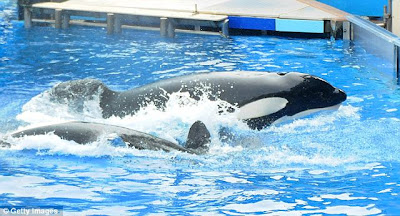 Flawless performance: There was no special reference made in yesterday's show to Tilikum's return
Flawless performance: There was no special reference made in yesterday's show to Tilikum's return The killer whale that drowned a female trainer at Orlando's SeaWorld performed flawlessly yesterday, for the first time since last year's tragedy.
Tilikum took part in the Florida marine park's signature Believe show, wowing thousands amid heightened safety that included a steel bar protecting the orca's trainers.
It was his first performance since dragging 40-year-old Dawn Brancheau from poolside by her pony tail and drowning her during a performance on February 24 last year.
 Back in action: Tilikum and his fellow orcas jumped in unison and splashed those in the front rows, delighting a crowd that filled the 5,000-seat Shamu Stadium to capacity
Back in action: Tilikum and his fellow orcas jumped in unison and splashed those in the front rows, delighting a crowd that filled the 5,000-seat Shamu Stadium to capacityTrainers on the platform stood behind the stout metal bar shaped as an inverted 'U' that was designed to prevent a whale from coming up out of the pool and biting and dragging a trainer into the water.
SeaWorld animal training curator Kelly Clark said returning Tilikum to performing more than a year later was best for the whale.
'Participating in shows is just a portion of Tilikum's day, but we feel it is an important component of his physical, social and mental enrichment,' she said.
'He has been regularly interacting with his trainers and the other whales for purposes of training, exercise and social and mental stimulation, and has enjoyed access to all of the pools in the Shamu Stadium complex.'
 Heightened safety: Trainers kept their distance during the performance. Tilikum has already been implicated in three deaths
Heightened safety: Trainers kept their distance during the performance. Tilikum has already been implicated in three deaths  'Free Tilly': SeaWorld animal training curator Kelly Clark said returning Tilikum to performing more than a year later was best for the whale, but demonstrations were held outside the arena
'Free Tilly': SeaWorld animal training curator Kelly Clark said returning Tilikum to performing more than a year later was best for the whale, but demonstrations were held outside the arenaThere was no special reference made in yesterday's show to Tilikum's return.
Nonetheless, Tilikum was the main draw for many. Orcas jumped in unison and splashed those in the front rows, delighting a crowd that filled the 5,000-seat Shamu Stadium to capacity.
No trainer has been allowed in the water during the shows since Ms Brancheau's death and they remained out of the pool yesterday. The closest the trainers got was the pool deck, standing behind the steel bar whenever they reached over to occasionally toss them a fish treat or stroke the whales when they flopped on the platform.
In the accident that killed Ms Brancheau, she was nose-to-nose with the whale when her pony tail floated into the animal's mouth and she was dragged in, authorities have said. She managed to free herself initially, but the whale continued to strike and thrash her, they added.
 Killer whale: It was Tilikum's first performance since killing trainer Dawn Brancheau, right, in a tragic poolside accident in February last year
Killer whale: It was Tilikum's first performance since killing trainer Dawn Brancheau, right, in a tragic poolside accident in February last year Dangerous: Ms Brancheau had been nose-to-nose with the whale when her pony tail floated into the animal's mouth and she was dragged in
Dangerous: Ms Brancheau had been nose-to-nose with the whale when her pony tail floated into the animal's mouth and she was dragged inSince the death, SeaWorld officials have drawn up plans to spend millions of dollars on safety upgrades. Measures include installing rising pool floors that can quickly lift people and the whales from the water, underwater vehicles to distract the marine animals in emergencies, and portable oxygen bottles for trainers.
But the day was not without protests nearby.
Many of those who went to see Tilikum perform drove past about a dozen protesters gathered outside SeaWorld's gates. The demonstrators complained that killer whales should not be held in captivity and several held up signs reading 'Free Tilly'.
source: dailymail




























































+The+quirky+new+calendar+that+uses+pets+to+spoof+the+rich+and+famous+1.jpg)


+1.jpg)